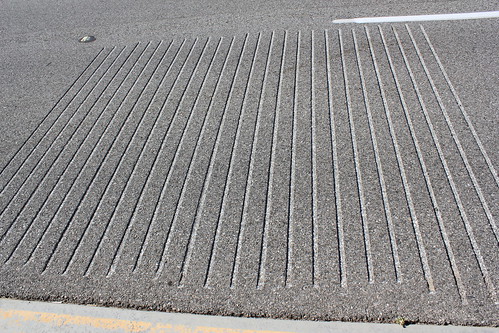Last year I visited the Musical Road in Lancaster, California. One of the reasons I went there, was to see if the second incarnation of the road was as badly out of tune as the original one, which was created by Honda for an advert.
Here is a recording I took from a microphone inside the car:
In case you are in doubt how the tune should sound (it is a bit of the William Tell Overture) here is a midi version [1]:
The road is never going to have the best musical timbre, but even allowing for that, nearly ever note in the tune is flat because most of the grooves have been spaced too far apart.

A musical road creates a tune out a set of grooves cut into a road. Every time the wheel hits a groove, it creates a little vibration. Where the grooves are spaced far apart, then these impulse are created one after the other at a slow rate and a low frequency note is created. When the grooves are close together the frequency of the note is higher because the impulses are created one after another more quickly. (It is similar to how a rumble strip at the side of a highway creates a buzz when you drive over them). Standing by the side of the road in Lancaster, you can clearly see the changing patterns of grooves with their different spacings.
Scientific Measurement

The above graph shows the frequency of road extracted from my audio recording compared to the correct frequency needed for the tune. If the musical road was in tune, all the blue diamonds would lie on the red line. The part of the William Tell Overture being reproduced spans an octave, so with a starting frequency of 217 Hz, I would expect the highest note to be at 434 Hz, but the road is painfully flat, producing 333 Hz.
I also took a tape measure and spent time dodging cars and measuring the physical size of the grooves and the spaces between. The important distance is the total of the spacing between adjacent grooves plus the width of one groove. Using this distance (along with the speed of the car), it is possible to calculate the frequency you would expect to hear. [2] As the graph below shows, the physics works exactly as expected. Given the physical dimensions I can predict the frequency I recorded on the audio quite accurately. There is nothing strange going on with the physics, the road has just been built with most of the grooves too close together.

What I can’t fathom, is why it was built wrong the second time? Didn’t anyone notice the old road needed re-tuning? Luckily, although it lacks musicality, it is still a lot of fun to drive over.
Sources
[1] http://davidsd.org/2008/12/honda-needs-a-tune-up/
[2] I set the car speed based on the frequency of the first note and used cruise control to keep the speed constant.
7 responses to “The unmusical, musical road”
Parts of the M1 used to sing because of the method used to finish the concrete surface. Instead of an old broom being used to make random drainage grooves a machine made regular grooves. The results were not musical!
Could you try it again using a linear regression of all the notes to choose the speed, rather than the first note?
Rather than choosing the first note to set the speed, how about doing a linear regression on all the notes, and using that?
It would still be out of tune because the frequency of a note is proportional to the speed of the car.
The lowest and highest notes in the tune are an octave apart on the musical score, which means there should be a doubling of frequency. This means the distance (spacing of adjacent grooves+groove width) should halve between the lowest and highest notes for this to give an octave (whatever the car speed). The distance was 12.3cm for the lowest note, and 8.0cm for the highest note. It can never be in tune.
Of course. Sorry about the double reply — I blame WordPress for that, but don’t have any excuse for my dim bulb speculation.
There is evidently a need for a published bit of software to calculate groove patterns from a musical score so that highway builders ignorant of acoustics can get it right.
[…] if the Lancaster Musical Road played a Christmas Carol? #HarkTheHerald. Here is my blog about the tuning problems of the old version. Or you can read about it in my book Sonic […]